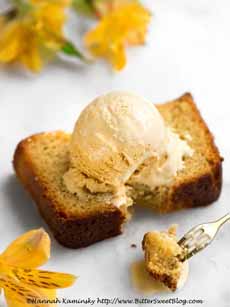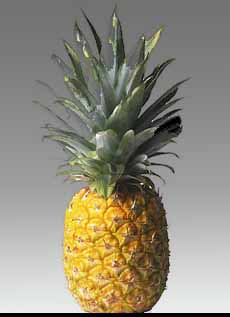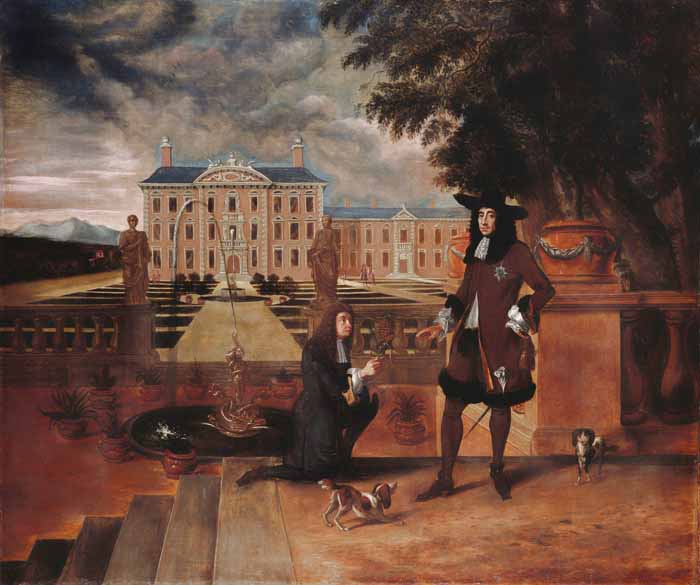RECIPE: Pineapple Pound Cake & The History Of Pineapple
 [1] Pineapple pound cake recipe (photos #1 and #2 plus recipe © Hannah Kaminsky | Bittersweet Blog).
|
Since the pineapple first reached Europe in the 15th century, it has been considered a symbol of hospitality. Pineapple was extremely costly, given its long voyage from the tropics. If you offered guests a pineapple, you were a generous host indeed. (The history of pineapple is below). Pineapples remained costly. If you recall the play and film Cabaret, in 1930s Berlin, when Herr Schultz brings Fräulein Schneider a pineapple during their courtship, she demurs that it is too generous a gift. > The history of pineapple is below. > Here’s the history of pound cake. Thanks to Hannah Kaminsky of Bittersweet Blog, for allowing us to republish her “pineapple story” and pineapple pound cake recipe. The story follows. “Reaching for the heavy brass door knocker standing guard at the entry of my childhood home, I never once questioned why it was fashioned after a pineapple. Design flourishes were not the first priority for the architects who constructed this traditional, simple New England colonial. “It could have been any shape, but of all the possible symbols to display to guests, the first thing that they grasp upon arrival is this tropical fruit. “It was because, I discovered, the pineapple was a symbol of generous hospitality. Pineapples, a delicious delight for Europeans (see the painting at the bottom), crossed the ocean in round-trips. “If the ships were slowed by bad weather, the fruit could rot; hence the great prices. To have such wealth that one could offer these esteemed fruits to visitors spoke of one’s prosperity and generosity.” The symbolism stuck. Today the average person can buy a fresh pineapple, and anyone can buy canned slices and pineapple juice. Ingredients For 1 Loaf (8-10 Servings) |
|
|
Preparation
1. MAKE the pineapple purée. Heat the oven to 400°F. Peel, core and dice the fruit before spreading the pieces evenly inside a casserole or baking dish. A good amount of juice will be expressed, so you need a vessel with fairly high sides. Bake, stirring every 15 minutes for 60 to 70 minutes, until caramelized. Cool completely before pureeing in a blender or food processor. Yield should be about 1-1/2 cups purée. This step can be done in advance. If refrigerated overnight, bring to room temperature before mixing into the recipe. If you have leftover purée, you can whip up a quick glaze by stirring in brown sugar and a pinch of cinnamon to taste. Cook the glaze in a pot on the stove until the sugar granules dissolve. Then drizzle or slather on top of the cooled loaf. 2. MAKE the cake. Preheat the oven to 350°F (or lower the temperature from step #1. Lightly grease and flour an 8 x 4-inch loaf pan and set aside. 3. STIR together in a large bowl the flour, white sugar, baking soda, baking powder, salt and ginger. Add the pineapple purée, oil, milk, vinegar and vanilla, mixing thoroughly until the batter is fairly smooth. It’s perfectly fine to leave a few lumps, rather than risk over-mixing and creating a tough crumb. 4. BAKE for 60 to 75 minutes or until a toothpick inserted in the center comes out clean. You may want to tent the loaf with foil half-way through the baking process if you fear it will turn out too dark. Remove the foil as soon as it comes out of the oven and let the cake cool in the pan for at least 30 minutes. Turn out onto a cooling rack to finish cooling, and serve either warm or at room temperature. —Hannah Kaminsky *Using olive oil instead of butter is a vegan option and a healthier option with fewer saturated fats (olive oil has 1.9 g/tablespoon, butter has 7 g/tablespoon). However, you can substitute melted butter for oil in a 1:1 proportion. However, while the butter provides buttery flavor, oil creates a moister cake. †If you would like to add the coconut flavor to cow’s milk, use 1/2 teaspoon coconut extract. The pineapple is indigenous to South America, believed to have originated around southern Brazil and Paraguay. The natives of that region carried the pineapple throughout South America via trade. It eventually reached the Caribbean, Central America and Mexico, where it was cultivated by the Mayas and the Aztecs. The first Europeans to see pineapples were Christopher Columbus and his crew, on the Caribbean island of Guadeloupe, in 1493. Columbus called them piña de Indes, pine of the Indians (because of its visual relation to pine cones). He brought them back to King Ferdinand in Spain. The exotic fruits were an instant hit in the royal court of Spain. The Portuguese took the fruit from Brazil to India by 1550. The Spanish introduced pineapple to Guam, Hawaii, The Philippines and Zimbabwe. It was brought to northern Europe by the Dutch, from their colony in Surinam. Given the time it took to go back and forth across the Atlantic to replenish the supply, King Ferdinand gave the order to perfect a hothouse, so the tropical plant could be grown in Spain. But that took almost 200 years. Even in the late 17th century, when they could be grown in a hothouse, pineapples remained so uncommon and coveted that King Charles II of England posed for an official portrait, in which he received a pineapple as a gift (photo #4). The gardeners of King Louis XV of France finally presented him with a pineapple that had been grown at Versailles, in 1733. Catherine the Great of Russia relished the pineapples grown on her estates. What to give the monarch or aristocrat who had everything? A pinery, the special hothouse created to grow pineapples. By the second half of the 18th century, the production of pineapples on British estates had become a great rivalry between wealthy aristocrats. Down to lesser wealthy mortals: A pineapple centerpiece on a formal dining table said much about a family’s affluence and rank in society. Guests were delighted just to see them. They weren’t eaten there: They were so expensive and so much in demand that confectioners would often rent them by the day (source)! By the latter 19th century, pineapple was being grown in Hawaii, largely in gardens. Large-scale cultivation by U.S. companies began in the early 1900s. Captain John Kidwell is most often credited with founding Hawaii’s pineapple industry, when he began crop development trials in 1885. However, in 1899 James Drummond Dole arrived and started a pineapple plantation, incorporated as the Hawaiian Pineapple Company, the following year. By 1901 he had pineapple crops on Oahu. Later, canneries were built. Del Monte was originally the name for private label coffee, made for the Hotel Del Monte in Monterey, California. It expanded into fruit distribution, and arrived more than 15 years after Dole to grow pineapples in Hawaii. By the middle of the 20th century there were eight pineapple companies in Hawaii, employing more than 3,000 people and growing 80% of the world’s pineapple. Today, Costa Rica, Brazil, and the Philippines grow nearly one-third of the world’s pineapples. India, Thailand, Nigeria, China, Indonesia, Mexico and Colombia are the next largest producers. Hawaii isn’t even on the Top 10 list. Del Monte moved its cultivation to Costa Rica; and by 2013, Dole grew only about 0.1% of the world’s production. CHECK OUT WHAT’S HAPPENING ON OUR HOME PAGE, THENIBBLE.COM. |
||





